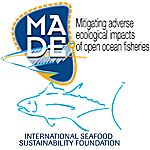One of the main challenges for marine science is to improve the understanding of factors affecting the relationship between population and recruitment as productivity is directly related to exploited population resilience. The increasing use of FADs has been hypothesized to affect the tuna movements/migrations leading them to low quality habitats, with potential detrimental effects on individual and/or population productivity. The objective of this study was to investigate body condition and tissue lipid class dynamics of yellowfin tuna in relation to their reproduction cycle as well as to evaluate the potential effects of school types (FADs vs. free-swimming schools) on these parameters. Morphometrics, condition factor, total lipid content as well as physiological indices (HSI, GSI) were measured on 102 females during the sexual maturation in the Western Indian Ocean in 2009/2010.
Results suggested that triacylglycerol, sterol- and wax-ester (WE-SE), phospholipids (TAG) and ketones were related to the processes involved in yellowfin sexual maturation. Moreover, a positive relationship between WE-SE and TAG distribution in gonads with GSI was shown, highlighting the importance of those lipid classes in the allocation energy strategy during maturation for this tropical tuna species. In contrast, no significant contribution of white muscle as energy resource for reproduction was observed. Finally, the preliminary results did not show any significant influence of fish associative behavior (FADs vs. free-swimming schools) on either tissue lipid class composition or total lipid content (Fatmeter analysis), which could suggest that the reproductive capacity of yellowfin tuna was not influenced by school type.

 PDF version
PDF version
